Corsair Obsidian Series 800D ATX Chassis Review
External Impressions
With the protective plastic from shipping removed you can get a better look at how the Corsair Obsidian Series 800D really looks. The steel structure has a matte black coating both inside out and is finished with a brushed aluminum faceplate.
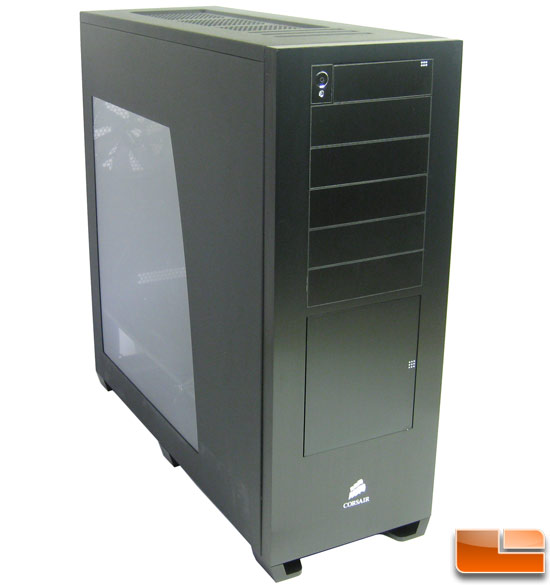
The Obsidian Series 800D chassis has very clean lines and has a hint of some of the Lian Li design heritage in it for sure. The Obsidian 800D comes with a uniquely shaped side window that you will either like or hate after you first glance at it. Corsair is not offering a solid steel door for this chassis, but if you really want one they will eventually be selling them on their accessory site. The white Corsair logo looks like a case badge, but it is actually painted on the front of the case. Those of you that don’t like branding on their case should be able to easily remove it with some chemicals and a little elbow grease.
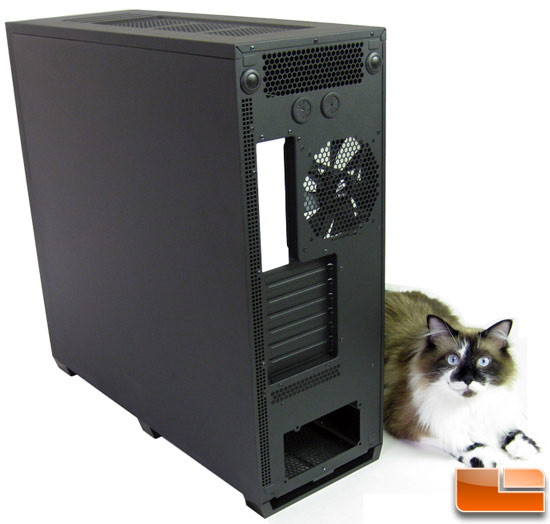
The back of the Obsidian 800D chassis has a nice clean design and you can see how the 800D dwarfs the 13 pound LR house cat! You can see from the image above that the power supply mounts at the bottom of the case and that ventilation holes are plentiful on the back of the chassis. The right side case door is solid steel and removes with a push of a button just like the left side door.
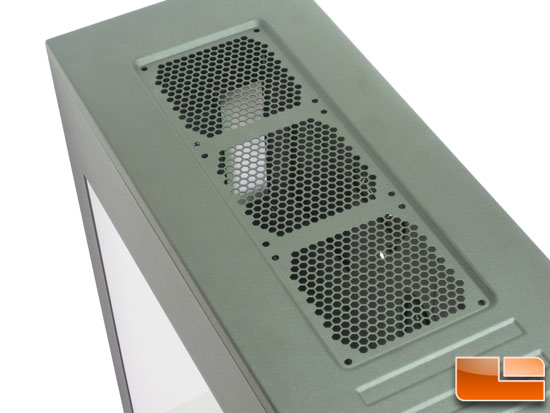
The top of the Obsidian 800D was designed with water cooling enthusiasts in mind and has pre-cut mounting holes for up to a 3x120mm radiator for those wanting to setup a nice water cooled system. If that isn’t your cup of tea, you can run three 120mm fans to help exhaust the hot air from the chassis. We’ll be installing a 2x120mm radiator a little later in this review, so keep reading to see how this case works out for water cooling. The top of the fan area has been recessed just slightly, which was likely done for extra strength and to keep the case lines looking clean as the screw heads for the radiator won’t be sticking up awkwardly. This recessed area can be better seen in the image below.
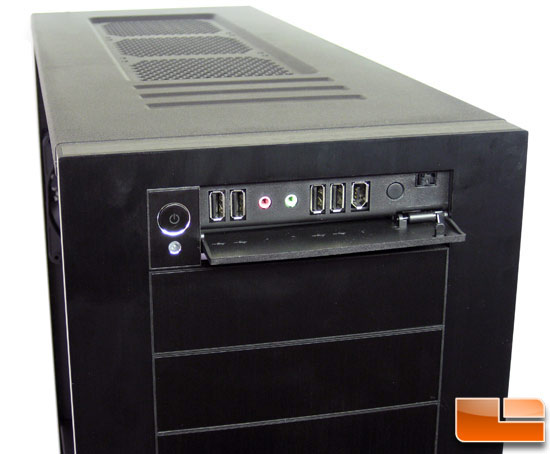
Just above the first 5.25″ drive bay resides the power button and the reset switch. Just to the right of those two switches is a front panel that covers the front I/O ports on the Obsidian Series 800D chassis. The included front I/O ports are four USB 2.0 connectors, one 6-pin Firewire connector, 3.5mm microphone and headphone stereo headers and the reset switch. The only thing missing from the front panel is External SATA (eSATA) as that format seems to be gaining popularity.
The cover is opened by pushing in on it and the door pops open. A plastic pin on each side of the cover holds it firmly to the case and the one on the lower right corner has a spring on it to slow the door release. This is nice feature, but our front I/O door arrived with the left plastic pin broken. Corsair might need to beef these plastic pins up or switch to metal on future revisions, for if they break during shipping we have to question how they will hold up after a couple of years of use.
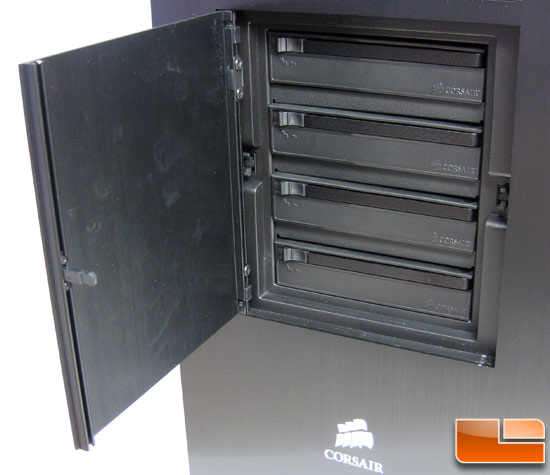
Below the five 5.25″ optical drive bays there is another small door that needs to be pressed on to pop open. Once opened you’ll see the four hot-swappable SATA drive bays that are used on the Obsidian Series 800D chassis. Each of the four 3.5″ storage drive caddies can be opened individually and support either 3.5″ or 2.5″ hard disk drives or solid-state drives.
The caddie door is reversible and it requires no tools to remove the door and flip it around. This is a nice touch as not everyone has their PC sitting in the same spot. The door on our prototype chassis was a little too tight and wouldn’t pop open every time. You can see that the door was dragging in the lower right corner as the black finish on the case is scuffed just a tad bit.
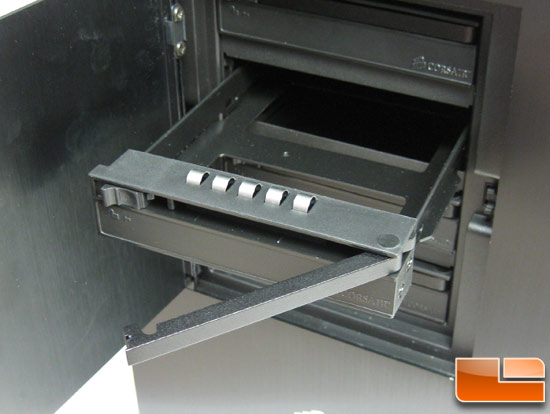
By sliding the locking mechanism a little lever will pop out, which is used to pull one of the caddies out of the hot-swap drive bay. The five little silver things on the top of the drive caddy are little springs that help hold the caddy firmly in place when installed and locked into place.
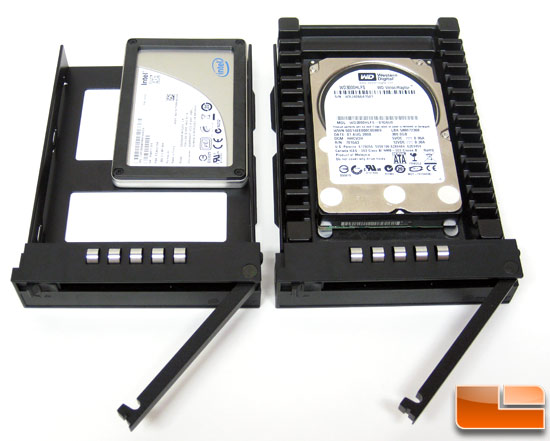
In order to use the hot swap bays you will need to mount your HDD or SSD to one of the four included caddies. No adapter is necessary for 2.5″ drives as the caddies have two holes in them for screws to hold 2.5″ notebook system drives. Pictured above is the Intel X-25M 160GB 34nm Gen 2 SSD and Western Digital VelociRaptor HDD installed in the drive caddies to show you what it will look like.
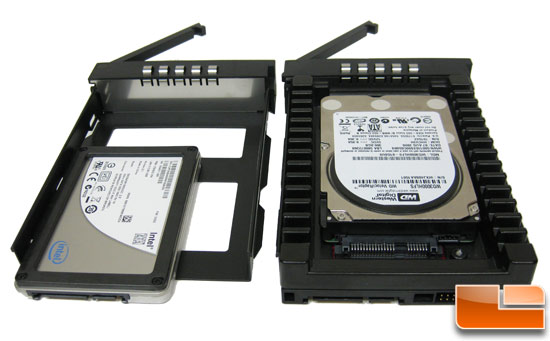
As you can see the SATA power and data connectors both end up at the same spot and slide right into the pre-configured SATA backplane.
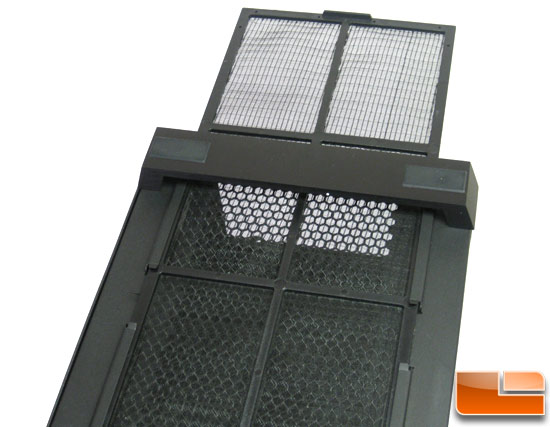
Flipping the Corsair Obsidian Series 800D chassis over reveals a very large removable dust filer that helps keep the dust level to a minimum. This picture also shows the pair of rubber pads that are put there to keep your floor or furniture from being damaged. Each of the three ‘legs’ features two of these pads, so there are six in total.

Comments are closed.